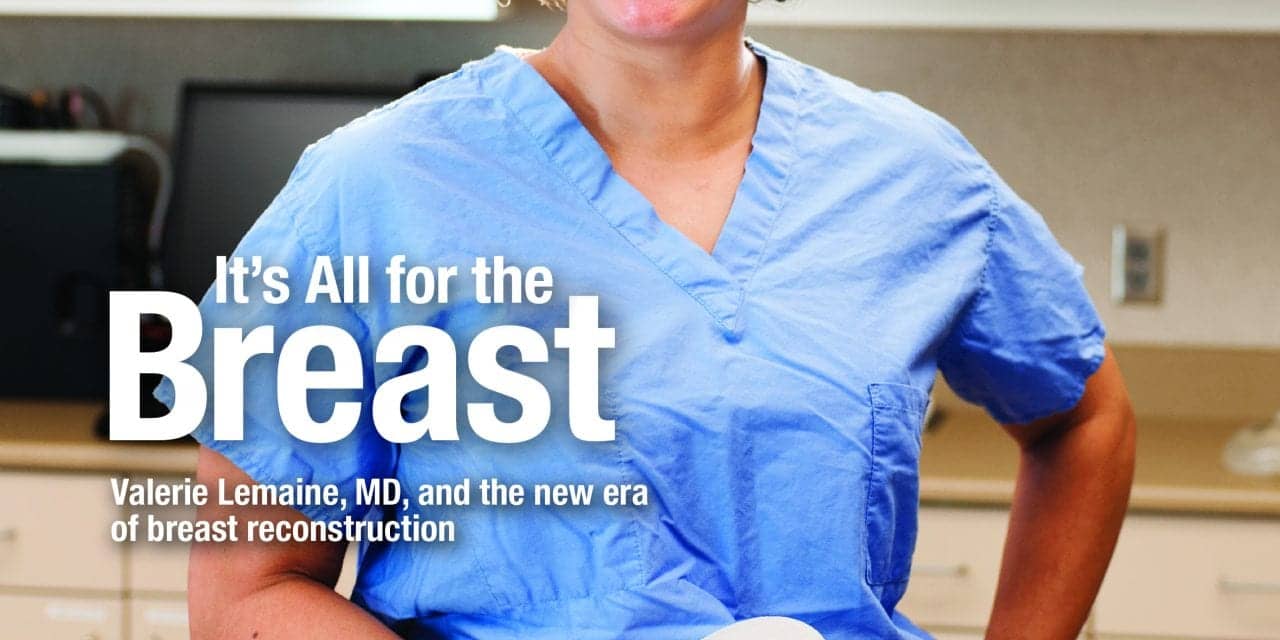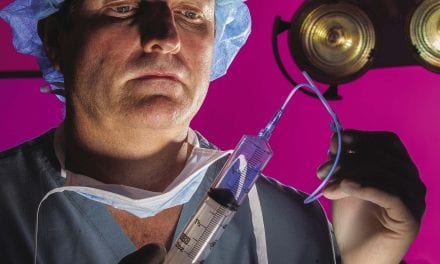Valerie Lemaine, MD, has spent most of the past 4 years performing breast reconstruction on women of all ages and backgrounds with various stages of breast cancer, as well as on those who face an increased risk of the cancer.
Until recently, however, she had never come face to face with a male breast reconstruction patient.
“The majority of, if not all, of male breast cancer patients don’t have reconstruction, and I am excited to offer something to this patient,” she says. The current treatment plan consists of fat grafting to correct a noticeable defect in breast symmetry.
Will he ever be the typical breast reconstruction patient? Likely not, but innovations in the surgery as well as legislation to engender insurance parity have made it possible for surgeons like Lemaine to offer breast reconstruction to all types of patients with all stages of disease—even those who don’t fit neatly into a box.
“What we can reconstruct today is definitely amazing. There are almost no limits—even if the breast cancer is aggressive,” says Lemaine, an assistant professor of plastic surgery ?and the vice chair for research in the Division of Plastic Surgery at Mayo Clinic in Rochester, Minn.
And growing numbers of women are choosing to have one or both breasts reconstructed following a breast cancer diagnosis or in efforts to ward off such a diagnosis. There was a 21% increase in breast reconstruction from 2000 to 2013, according to statistics from the American Society of Plastic Surgeons.
From new microsurgery techniques and the approval of three form-stable breast implants to growing confidence regarding the use of autologous fat grafting and the advent of intraoperative angiography, breast reconstruction advances have been fast and furious in recent years, so much so that the surgery is morphing from a solely reconstructive procedure to an aesthetic one.
This has raised the stakes for many reconstructive surgeons, as patients now hope to look better than they did before their mastectomy.
As Good as it Gets
Lemaine’s background has prepared her for the challenge. She completed her plastic surgery residency at the University of Montreal, where she served as chief resident. Next up was a 1-year microsurgery fellowship at Memorial Sloan Kettering Cancer Center in New York City. She stayed on there to complete a clinical research fellowship, and at the same time pursued her MPH from Columbia University. The Mayo Clinic recruited Lemaine to expand its microsurgery program in 2010—and this program’s growth has coincided with Lemaine’s service as well as technical advances in breast microsurgery.
Breast microsurgery arrived on the scene in the 1980s, when surgeons first began transferring abdominal tissue to the breast area. “Today, we can harvest flaps from other areas of the body, but the abdomen remains the most popular donor site,” she says. “With the advances in perforator flap surgery, we are now able to harvest the skin and subcutaneous tissue with very little or no muscle, and this allows us to dramatically minimize the morbidity associated with the procedure,” she says.
“The most exciting advance right now is lymphatic surgery, which allows us to use supermicrosurgical techniques to treat lymphedema, which is seen in some breast cancer survivors.” Much credit goes to intraoperative angiography, she says. This technology has helped decrease the incidence of perfusion-related complications during breast microsurgery, but one of its most critical indications is for lymphatic surgery, Lemaine says.
Support Systems
Microsurgery refinements have not been the only breast reconstruction innovation realized in recent times. First described for use in breast surgery in 2001, acellular dermal matrices (ADMs) have been another game change in breast reconstruction. “These allowed us to push tissue expansion to the next level and even offer direct-to-implant breast reconstruction to some patients,” she says.
Yes, they provide excellent soft-tissue support, but ADMs are not without their share of downsides, including higher rates of postoperative seroma and infection. “Newer biologic scaffolding materials also offer soft-tissue support during breast reconstruction and revision breast surgery, and may have a different complication profile than ADMs,” Lemaine says.
More options for soft-tissue support have definitely made a difference for breast surgeons and breast reconstruction patients, agrees Kamakshi R. Zeidler, MD, an aesthetic and reconstructive plastic surgeon in the Los Gatos, San Jose, and greater South Bay Area of California.
“ADMs and tissue scaffolds have blossomed in the past several years, allowing us to pick and choose the right matrix for the right application—from softer, rapidly incorporating products that stretch with expansion like Alloderm, to stronger products like Strattice™, Seri® Scaffold, [GalaFLEX mesh], or TIGR® matrix when you need strong andlasting support for revisionary surgeries,” Zeidler says.
New form-stable breast implants, too, are improving the aesthetics of breast reconstruction. “Reconstruction patients benefit the most from the natural slope of the superior pole of these implants,” Zeidler says. “Now, patients who want a ‘natural’ look don’t necessarily have to choose more invasive autologous reconstructive procedures,” she says.
Fat Chance
Fat grafting is increasingly playing a role in today’s breast reconstruction. “A little fat can go a long way and help turn a good reconstruction into an outstanding one,” Zeidler says. “Fat allows us to fill in defects like spackle on a wall, make up for size differentials, and add a layer of icing on the cake—making implants look more soft and natural, and allowing us to fine-tune any type of reconstruction.”
Lemaine agrees. “Fat grafting is now a part of every single breast reconstruction operation I perform. Women love the results, both because it enhances their breasts and also the body part where the fat is harvested,” she says. “After a mastectomy and breast reconstruction with implants or autologous tissue, contour deformities often persist, and fat grafting allows plastic surgeons to create smoother contours, fill gaps, and create a reconstructed breast that looks natural,” she says. Fat grafting can also help women who underwent breast conservation therapy and are left with misshapen breasts after radiation therapy. “It definitely transforms the reconstruction into a work of art. It is a powerful tool!”
Re-creating the nipple-areola complex is typically the last stage of breast reconstruction. Four years ago, surgeons just started to offer nipple-sparing mastectomies. “Now, we offer nipple-sparing mastectomy to more than one-third of mastectomy patients who come to Mayo Clinic, and even push the boundaries further by combining a mastopexy when necessary,” Lemaine says. “This would not have been possible before intraoperative angiography was available.”
This trend has led to a lesser need for nipple reconstruction, but there have been significant advances in rebuilding the nipple-areola complex. “We can create a nipple with a variety of flaps, with or without a skin graft,” Lemaine says. Optimal projection of the new nipple remains challenging, but cylinder scaffolds and ADMs can make a difference. “Nipple sharing also has a role in unilateral reconstruction, assuming that the nipple on the other side is large enough,” Lemaine says. “These are the ones that look the most natural.” Some patients may opt for the extremely lifelike 3D tattooing. “The reason there are so many techniques for nipple reconstruction is that no one technique is perfect,” she says.
Room for Improvement
While reconstruction has improved greatly and more individuals are aware of their options, there are still some subsets of women who are less likely to pursue reconstruction. For example, Dartmouth researchers found that African American women are 55% less likely to receive breast reconstruction after mastectomy regardless of where they received their care.
Exactly why this is occurring is not fully understood, Lemaine says. “Many African American and Hispanic women have reservations about breast implants and foreign bodies, and prefer autologous options if they are interested in pursuing breast reconstruction,” she says. Some cultural aspects may also be at play here, she adds. “These women may not be fully aware of what is available for breast reconstruction, and there are likely access to care issues as well,” she says.
Efforts to improve access to care alongside grassroots education about options and innovations will likely take hold, and African American women’s rates of breast reconstruction may then catch up with other populations.
“We can do a lot more and a lot better today than we were able to do a few decades ago, but until we cure breast cancer, there will always be room for improvement,” she says.
Denise Mann is the editor of Plastic Surgery Practice. She can be reached at [email protected].



